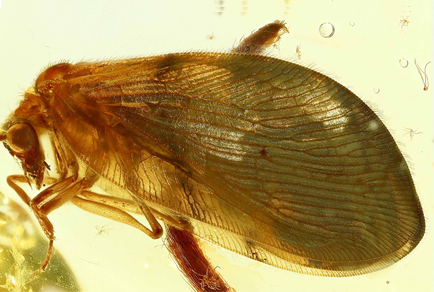Abstract
Proneuronema damzeni sp. nov. (Neuroptera: Hemerobiidae) is described from late Eocene Ukrainian Rovno amber. It differs from the two other species of this Eocene genus by a combination of the following character states: forewing larger (7.3 mm long in the new species; 6.3–6.9 mm in P. minor Makarkin et al., 2016; 5.9 mm in P. sydorchukae Makarkin & Perkovsky, 2020) and broader (length to width ratio is 2.14 in the new species; 2.46 in P. sydorchukae; 2.17–2.30 in P. minor), and different forewing maculation (one spot at the third (‘inner’) gradate series in the new species; two in P. sydorchukae; none in P. minor). The Fur Formation Megalomus densistriatus Henriksen, 1922 and the Baltic amber Proneuronema gradatum Makarkin et al., 2016 are preliminary assigned to Archibaldia Makarkin, 2023 as Archibaldia densistriata, comb. nov. and A. gradata, comb. nov., respectively. The species composition and distribution of Proneuronema and Archibaldia are briefly discussed.
References
- Breitkreuz, L.C.V., Winterton, S.L. & Engel, M.S. (2017) Wing tracheation in Chrysopidae and other Neuropterida (Insecta): A resolution of the confusion about vein fusion. American Museum Novitates, 3890, 1–44. https://doi.org/10.1206/3890.1
- Henriksen, K.L. (1922) Eocene insects from Denmark. Danmarks Geologiske Undersogelse, 2 (37), 1–36. https://doi.org/10.34194/raekke2.v37.6823
- Krüger, L. (1922) Hemerobiidae. Beiträge zu einer Monographie der Neuropteren-Familie der Hemerobiiden. Stettiner Entomologische Zeitung, 83, 138–172.
- Larsson, S.G. (1975) Palaeobiology and mode of burial of the insects of the Lower Eocene Mo-clay of Denmark. Bulletin of the Geological Society of Denmark, 24, 193–209.
- Leach, W.E. (1815) Entomology. In: Brewster, D. (Ed.), Edinburgh Encyclopaedia. Vol. 9, pt. 1. Edinburgh, pp. 57–172.
- Li, S.M., Ren, D., Yang, Q. & Shi, C.F. (2023) A new brown lacewing (Neuroptera: Hemerobiidae) from mid-Cretaceous Myanmar amber. Palaeoentomology, 6 (5), 533–541. https://doi.org/10.11646/palaeoentomology.6.5.12
- Linnaeus, C. (1758) Systema naturae per regna tria naturae secundum classes, ordines, genera, species, cum characteribus, differentiis, synonymis, locis, 10th ed. Vol. 1. Salvii, Holmiae, 824 pp. https://doi.org/10.5962/bhl.title.542
- Makarkin, V.N. (2023) Fossil Hemerobiidae (Neuroptera) from the Eocene Tadushi Formation, the Russian Far East, with description of a new genus. Zootaxa, 5297 (1), 115–123. https://doi.org/10.11646/zootaxa.5297.1.6
- Makarkin, V.N. (2024) First brown lacewings (Neuroptera: Hemerobiidae) from the early Eocene Green River Formation. Zootaxa, 5501 (1), 160–170. https://doi.org/10.11646/zootaxa.5501.1.7
- Makarkin, V.N., Archibald, S.B. & Oswald, J.D. (2003) New Early Eocene brown lacewings (Neuroptera: Hemerobiidae) from western North America. Canadian Entomologist, 135 (5), 637–653. https://doi.org/10.4039/n02-122
- Makarkin, V.N. & Perkovsky, E.E. (2020) A new species of Proneuronema (Neuroptera, Hemerobiidae) from the late Eocene Rovno amber. Zootaxa, 4718 (2), 292–300. https://doi.org/10.11646/zootaxa.4718.2.11
- Makarkin V.N., Wedmann S. & Weiterschan T. (2016) A new genus of Hemerobiidae (Neuroptera) from Baltic amber, with a critical review of the Cenozoic Megalomus-like taxa and remarks on the wing venation variability of the family. Zootaxa, 4179 (3), 345–370. https://doi.org/10.11646/zootaxa.4179.3.2
- Obst, K. & Ansorge, J. (2012) Exkursionsführer Geologie und Landschaftsentwicklung der Greifswalder Oie (Exkursion D am 12. April 2012). Jahresberichte und Mitteilungen des Oberrheinischen Geologischen Vereins, N.F., 94, 213–264. https://doi.org/10.1127/jmogv/94/2012/213
- Oswald, J.D. (1993) Revision and cladistic analysis of the world genera of the family Hemerobiidae (Insecta: Neuroptera). Journal of the New York Entomological Society, 101, 143–299.
- Rust, J. (1999) Biologie der Insekten aus dem ältesten Tertiär Nordeuropas. Habilitationsschrift zur Erlangung der venia legendi für das Fach Zoologie in der biologischen Fakultät der Georg-August-Universitäat Göttingen, Göttingen, 482 pp.


